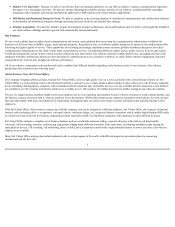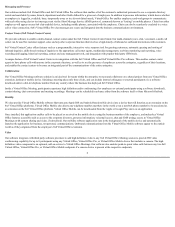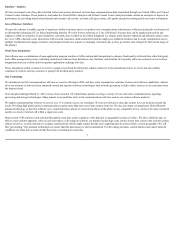8x8 2016 Annual Report Download - page 17
Download and view the complete annual report
Please find page 17 of the 2016 8x8 annual report below. You can navigate through the pages in the report by either clicking on the pages listed below, or by using the keyword search tool below to find specific information within the annual report.
and larger distributed enterprises, our results of operations and our overall ability to grow our customer base could be materially and adversely affected.
Intense competition in the markets in which we compete could prevent us from increasing or sustaining our revenue growth and increasing or
maintaining profitability.
The business of cloud software solutions is competitive, and we expect it to become increasingly competitive in the future. We may also face competition from
large Internet companies, any of which might launch its own cloud-based business communications services or acquire other cloud-based business communications
companies in the future.
In connection with our cloud software communication services, we face competition from providers of cloud communication and contact center software services,
such as RingCentral, Fuze, inContact, Five9, and Interactive Intelligence. In addition, because most of our target customers are already purchasing
communications services from incumbent telephone companies reselling legacy communication equipment, our success is dependent upon our ability to attract
these customers away from their existing providers. These competitors include AT&T, CenturyLink, Comcast and Verizon Communications in conjunction with
on-premises hardware solutions from companies like Avaya, Cisco and Mitel. We also face competition from communications and collaboration vendors such as
Cisco, Google, and Microsoft Corporation. Cisco and Microsoft, in particular, have recently signalled publicly their intent to begin competing more aggressively
in the cloud communications market.
Many of our current and potential competitors have longer operating histories, significantly greater resources and brand awareness, and a larger base of customers
than we have. As a result, these competitors may have greater credibility with our existing and potential customers. They also may be able to adopt more
aggressive pricing policies and devote greater resources to the development, promotion and sale of their products than we can to ours. Our competitors may also
offer bundled service arrangements that offer a more complete or better integrated product to customers. Competition could decrease our prices, reduce our sales,
lower our gross profits or decrease our market share. In addition, many of our customers are not subject to long-term contractual commitments to purchase our
services and can terminate our service and switch to competitors' offerings on short notice.
Given the significant price competition in the markets for our services, we are at a significant disadvantage compared with many of our competitors, especially
those with substantially greater resources who may be better able to withstand an extended period of downward pricing pressure. The adverse impact of a shortfall
in our revenues may be magnified by our inability to adjust our expenses to compensate for such shortfall. Announcements, or expectations, as to the introduction
of new products and technologies by our competitors or us could cause customers to defer purchases of our existing products, which also could have a material
adverse effect on our business, financial condition or operating results.
Because we recognize revenue from customer subscriptions over the term of the relevant contract, the effects of customer additions, cancellations and
changes in subscribed services are not immediately reflected in full in our operating results.
As a subscription-based business, we recognize revenue over the term of each of our contracts, which generally range from one to three years. As a result, much of
the revenue we report each quarter results from contracts entered into during previous quarters. Consequently, a shortfall in demand for our cloud software
solutions or a decline in new or renewed contracts in any one quarter may not significantly reduce our revenue for that quarter but could negatively affect our
revenue in future quarters. Accordingly, the effect of significant downturns in new sales or cancellations of our services and subscriptions from new customers or
for additional services from existing customers will impact our ongoing monthly recurring revenue but will not be reflected fully in our operating results until
future periods. Our revenue recognition model also makes it difficult for us to rapidly increase our revenue through additional sales in any period, as revenue from
new customers must be recognized over the applicable term of the contracts.
We have a history of losses and are uncertain of our future profitability.
We recorded an operating loss of $7.1 million for the fiscal year ended March 31, 2016 and ended the period with an accumulated deficit of $109.9 million.
Although we have achieved operating income in four of our five most recent fiscal years, we incurred substantial operating losses prior to that and may incur
operating losses in the future, which may be substantial. As we expand our geographic reach and service offerings, and further invest in research and development,
sales and marketing, and regulatory compliance, we will need to increase revenues in order to generate sustainable operating profit. Given our history of fluctuating
revenues and operating losses, we cannot be certain that we will be able to achieve or maintain operating profitability on an annual basis or on a quarterly basis in
the future.
14
























